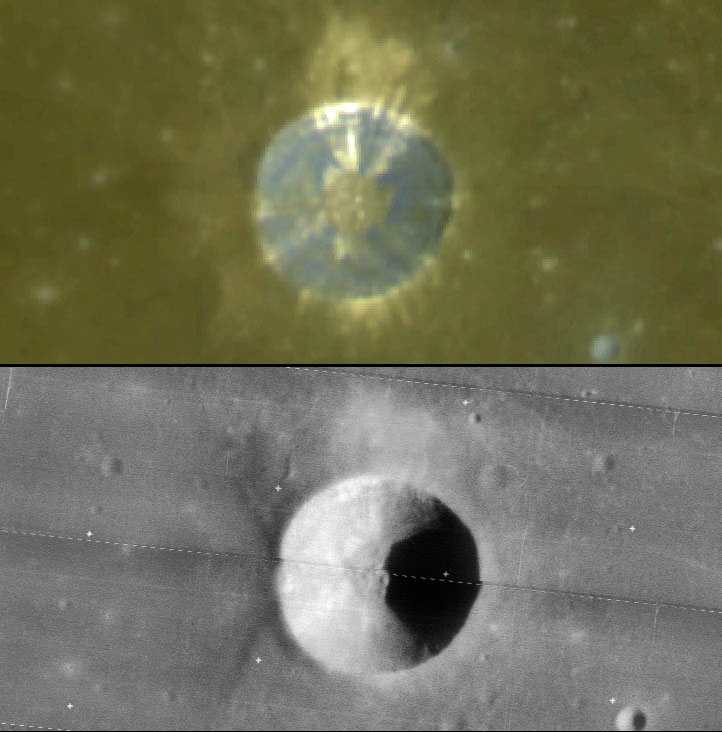Difference between revisions of "August 13, 2018"
(Created page with "__NOTOC__ =Cauchy Times Two= Originally published May 31, 2009 <!-- Start of content --> <!-- ws:start:WikiTextHeadingRule:2:<h1> --> <!-- ws:start:WikiTextLocalIma...") |
|||
| Line 7: | Line 7: | ||
<em>images from [http://www.mapaplanet.org/explorer/moon.html USGS Map-A-Planet]</em><br /> | <em>images from [http://www.mapaplanet.org/explorer/moon.html USGS Map-A-Planet]</em><br /> | ||
<br /> | <br /> | ||
| − | [http://www.mapaplanet.org/explorer/moon.html Map-A-Planet] is a great resource, especially since it makes easy the comparison of a feature in Clementine and Lunar Orbiter IV images. For example, here is the Clementine UV-VIS muliti-spectral image and the LO for the 12 km diameter simple crater Cauchy. Almost no craters smaller than 10 km diameter have central peaks, but in the rise toward 20 diameter, peaks became progressive more abundant in simple craters. When I cataloged Cauchy for the <em>[ | + | [http://www.mapaplanet.org/explorer/moon.html Map-A-Planet] is a great resource, especially since it makes easy the comparison of a feature in Clementine and Lunar Orbiter IV images. For example, here is the Clementine UV-VIS muliti-spectral image and the LO for the 12 km diameter simple crater Cauchy. Almost no craters smaller than 10 km diameter have central peaks, but in the rise toward 20 diameter, peaks became progressive more abundant in simple craters. When I cataloged Cauchy for the <em>[https://the-moon.us/wiki/System+of+Lunar+Craters System of Lunar Craters]</em> using the best telescopic images, no peak could be detected, but the LO and Clementine clearly reveal two distinct peaklets and smaller hills on its flat floor. As with nearly all simple craters, the inner wall of Cauchy looks like it would be a smooth slide to the floor. There is bright material on the northern rim that has slid downslope, making a bright streak; interestingly the biggest area of bright nimbus surrounding the crater is adjacent to this bright part of the rim. A dark band is visible about 25% of the way down from the rim crest - is this a resistant layer of Tranquillitatis lava? Finally, as seen on the LO image, the western side of Cauchy has two short ridges that intersect the rim in a V pattern. Danny Caes [https://the-moon.us/wiki/Cauchy first] noticed this wing-like feature. It looks similar to the chevron pattern of ejecta seen at low angle secondary craters. Cauchy is not a secondary, but perhaps it was an oblique impact.<br /> |
<br /> | <br /> | ||
<em>[mailto:tychocrater@yahoo.com Chuck Wood]</em><br /> | <em>[mailto:tychocrater@yahoo.com Chuck Wood]</em><br /> | ||
<br /> | <br /> | ||
<strong>Related Links</strong><br /> | <strong>Related Links</strong><br /> | ||
| − | Rükl plate [ | + | Rükl plate [https://the-moon.us/wiki/Rukl+36 36]<br /> |
<br /> | <br /> | ||
<p><b>Yesterday's LPOD:</b> [[August 12, 2018|Textured Contrasts]] </p> | <p><b>Yesterday's LPOD:</b> [[August 12, 2018|Textured Contrasts]] </p> | ||
Revision as of 18:05, 18 August 2018
Cauchy Times Two
Originally published May 31, 2009

images from USGS Map-A-Planet
Map-A-Planet is a great resource, especially since it makes easy the comparison of a feature in Clementine and Lunar Orbiter IV images. For example, here is the Clementine UV-VIS muliti-spectral image and the LO for the 12 km diameter simple crater Cauchy. Almost no craters smaller than 10 km diameter have central peaks, but in the rise toward 20 diameter, peaks became progressive more abundant in simple craters. When I cataloged Cauchy for the System of Lunar Craters using the best telescopic images, no peak could be detected, but the LO and Clementine clearly reveal two distinct peaklets and smaller hills on its flat floor. As with nearly all simple craters, the inner wall of Cauchy looks like it would be a smooth slide to the floor. There is bright material on the northern rim that has slid downslope, making a bright streak; interestingly the biggest area of bright nimbus surrounding the crater is adjacent to this bright part of the rim. A dark band is visible about 25% of the way down from the rim crest - is this a resistant layer of Tranquillitatis lava? Finally, as seen on the LO image, the western side of Cauchy has two short ridges that intersect the rim in a V pattern. Danny Caes first noticed this wing-like feature. It looks similar to the chevron pattern of ejecta seen at low angle secondary craters. Cauchy is not a secondary, but perhaps it was an oblique impact.
Chuck Wood
Related Links
Rükl plate 36
Yesterday's LPOD: Textured Contrasts
Tomorrow's LPOD: Ejecta Tales
COMMENTS?
Register, Log in, and join in the comments.



